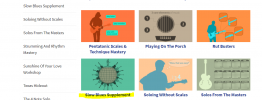SuzanneShafer
Addicted to Bikes & Blues
I learn a lot from Griff's emails, and this particular one could not have been more timely. The day before receiving it, I spent about three hours trying to figure out how to use a Mixolydian/Blues Hybrid Scale for soloing...to no avail. But when Griff talked about using a hybrid of the Blues Box 1 and Major Box 2, his idea made perfect sense to me. It also lifted my spirits because I already knew both boxes and had no trouble moving between them, and what Griff was doing with them felt like something I could actually do. Griff talked about using the major scale notes when going up on strings 1 to 3, and the minor ones when going down. To cement what I had learned from the video, I set about creating a diagram that would help me remember which notes were which, and help me better understand why Griff's idea works so well. Imagine my surprise when I realized that the blending of the two Boxes actually creates the very Mixolydian scale I had gotten nowhere with the day before. Griff's way of presenting it made all the difference!
I'm a visual learner, and in case someone else is too and might benefit from my diagram, I have attached it. The notations inside the diagram's dots are related to musical theory. You don't really need to understand them to use the diagram. The color-coded dots may be sufficient for you. But that level of detail is important to my own learning process and, in this case, revealed some patterns I would have otherwise missed.
If you missed the email, here is the link to Griff's video: https://www.youtube.com/watch?v=rJz1OWDs8ks&feature=emb_imp_woyt
I'm a visual learner, and in case someone else is too and might benefit from my diagram, I have attached it. The notations inside the diagram's dots are related to musical theory. You don't really need to understand them to use the diagram. The color-coded dots may be sufficient for you. But that level of detail is important to my own learning process and, in this case, revealed some patterns I would have otherwise missed.
If you missed the email, here is the link to Griff's video: https://www.youtube.com/watch?v=rJz1OWDs8ks&feature=emb_imp_woyt

